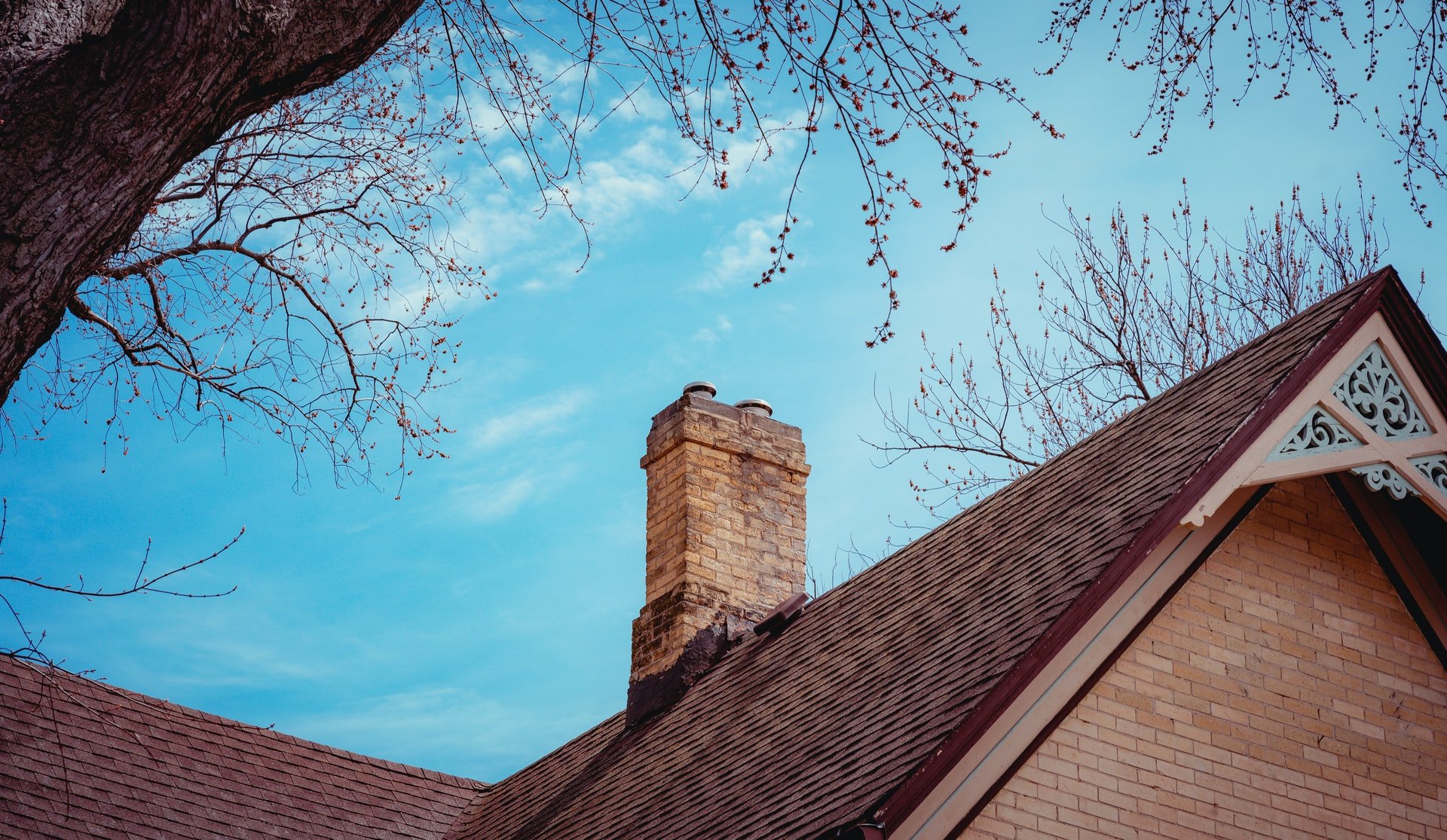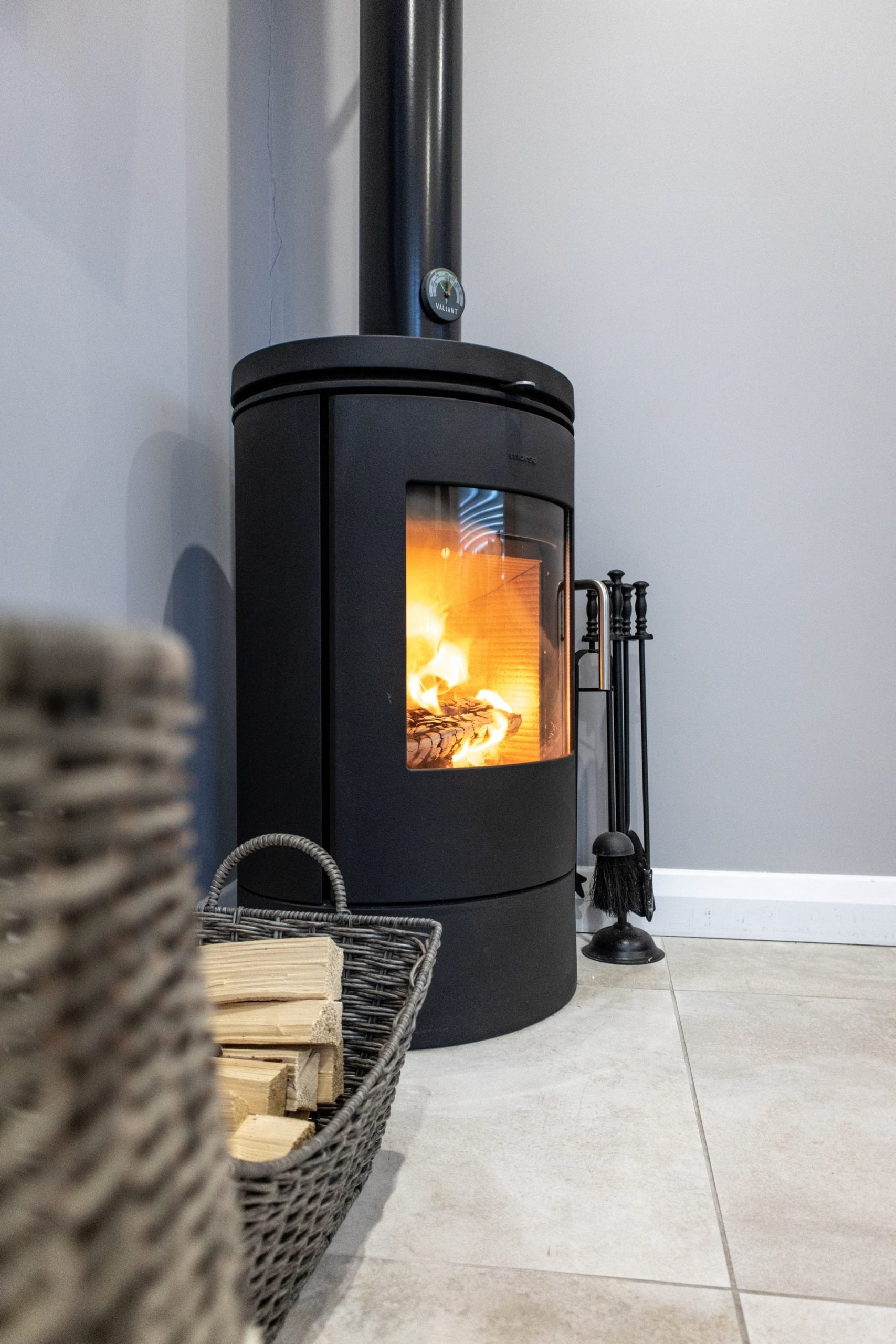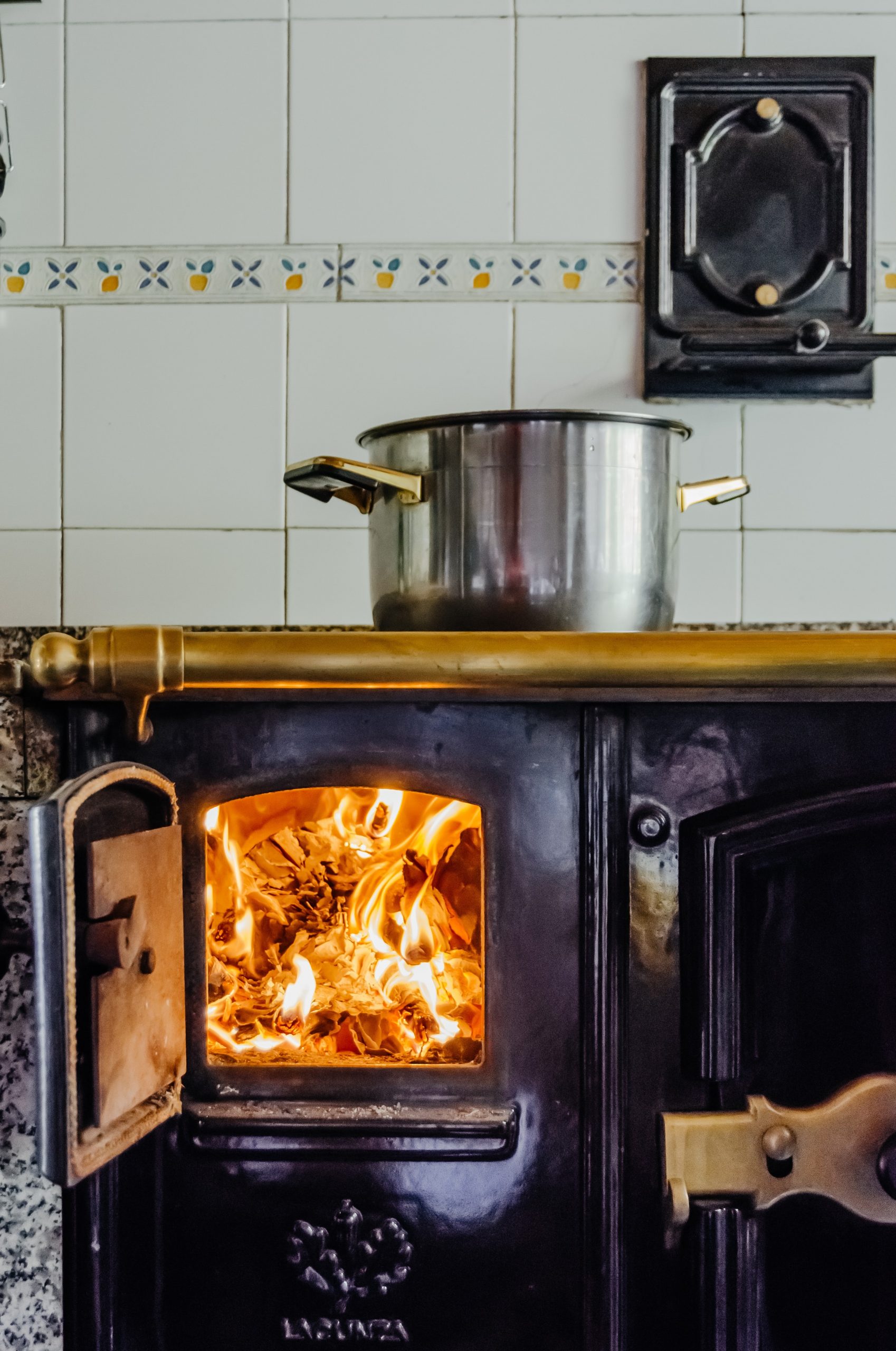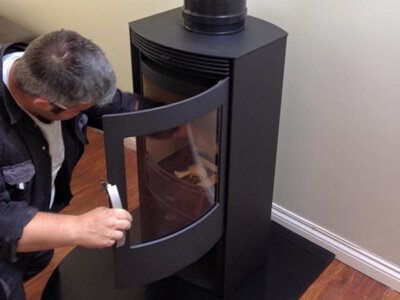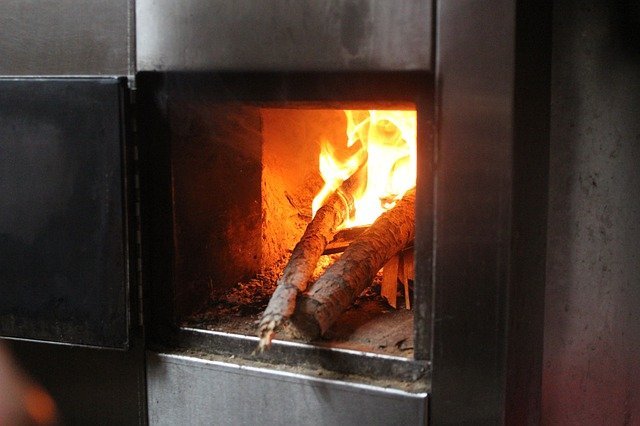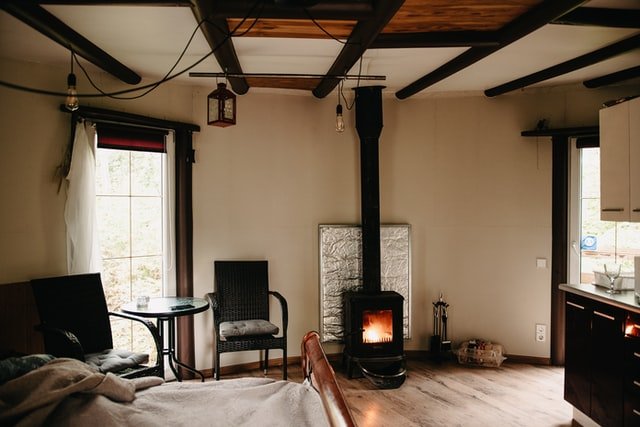Do You Need a Chimney to Have a Wood Burning Stove?
There are plenty of reasons to want a wood-burning stove—from the satisfaction of cooking over solid burnt fuel to the heat it can provide your home. You can even save on firewood costs as this allows you to control the fire and burn wood slower and more efficiently.
However, most modern homes do not have a chimney. Luckily, thanks to modern design and technology, you don’t really need it. Today’s wood-burning stoves are a more cost-efficient addition to your home.
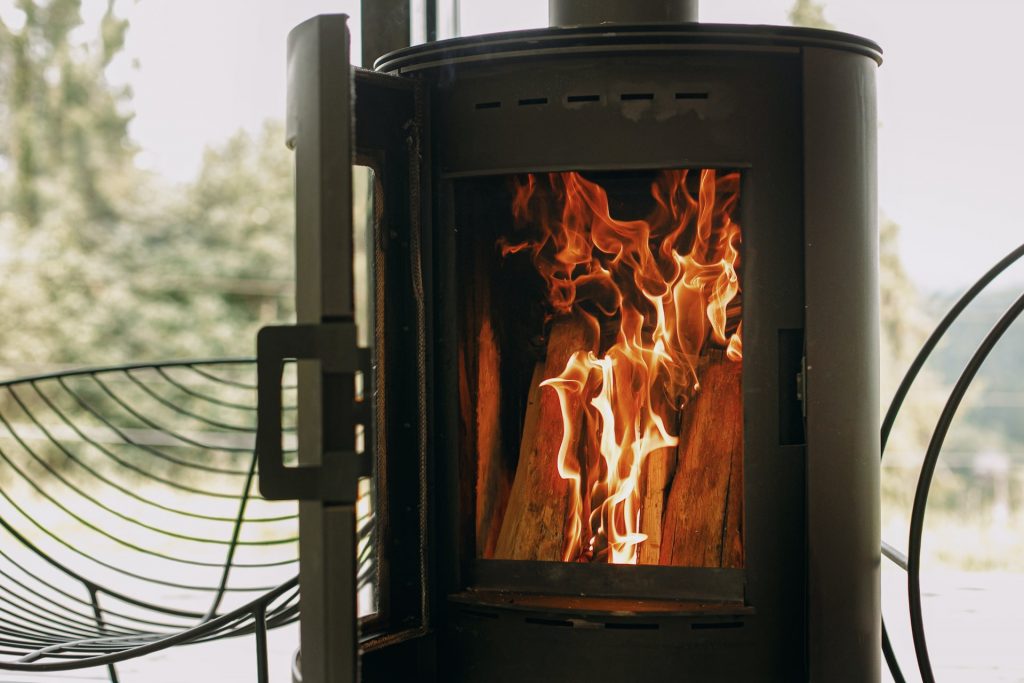
Here is how you can have a wood-burning stove without a chimney in your home:
Twin Wall Chimney Flue System
A twin wall flue system is basically a series of connectable stainless steel pipes that carry the fumes of your stove outside, just like a chimney but a lot more effective and adjustable. The stainless steel pipes are wrapped in thick insulation and encased in an outer tube to ensure that the heat is not dangerous.
There are two ways that you can install a twin wall flue:
- Externally—with this option, the pipe is connected to the stove and exits through an external wall. Then it runs up the side of the building to empty at a safe distance near the roof.
- Internally—here, the pipe is connected to your stove, and it runs through the inside of your home, through the ceilings, and out to the roof to empty.
Installing a Wood Burner
The first thing you need to do is call a professional (if you’re not one yourself). Installing a wood burner can be a tricky process if you’re not familiar with what you’re doing. While some parts are manageable on your own, you might need a professional to ensure the safety and reliability of your stove. Professionals will know how to fit the pipes to your house in the best way possible.
To give you an idea of what to expect when installing a wood burner are the things you will need:
- Stove
- Stovepipe
- Twin wall flue system
- Hearth
Twin Flue Chimney Regulations
Installing a twin wall flue system is the best solution for people who need a stove but don’t have a chimney. Whether you’re installing it yourself or with the help of a professional, you must know the regulations you have to follow to ensure that your installation is safe and secure.
Here are the regulations you must follow:
- The entire length of the twin wall system must not have more than four bends.
- None of the bends should be more than a 45-degree angle, excluding the connection to the stove, which may be 90 degrees.
- Your non-insulated stove pipe cannot be used to go through the wall or ceiling—only your twin wall flue can do this.
- Your stove pipe should be kept at least 425 mm away from any combustible materials.
The Bottom Line
You can get a wood-burning stove without a chimney. Luckily, the process is not all that complicated, especially if you have help from a professional. The most challenging aspect you might face is choosing the right stove and installing it internally or externally. Whatever you choose, once it’s all done, your home will be all the better for it. Aside from easy cooking, you will have a reliable source of heat inside your home.
If you need help with stove installation, we’re the right people to help you. Here at Stove Scotland, we will work with you to ensure that your stove will perfectly fit the style and dimensions of your room. You can count on us to get your stove right. Contact us today and let us know how we can help you!
Wood Burning Stoves: What You Need to Know
Stoves are a vital part of any kitchen—it’s where food is cooked, after all. There are many kinds of stoves available, such as electric stoves and gas stoves. However, one type of stove is not often seen in most homes: the wood-burning stove.
Before we go any further, it’s important to note that wood-burning stoves are not used for cooking and are often used as a fireplace. A wood-burning stove, as the name implies, uses wood as fuel.
For others, it’s good to use such a stove because it’s easy to find wood. With this in mind, it’s essential to know how to use a wood-burning stove properly, and you should also be able to maximise its lifespan.
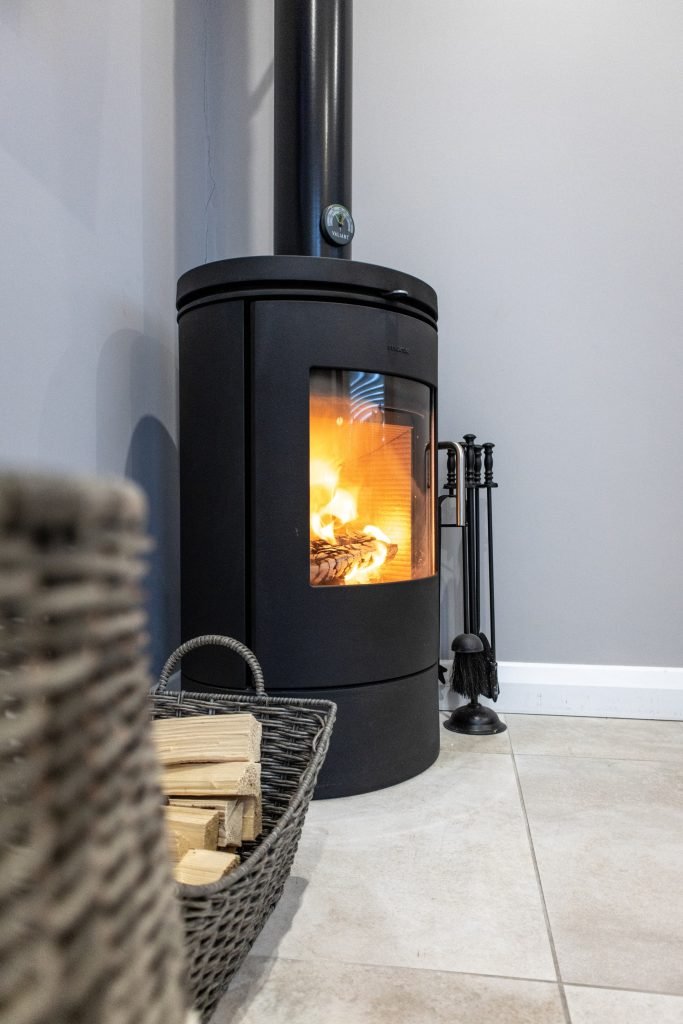
What exactly is there to know about wood-burning stoves? In this article, we’ll shed some light on the matter at hand. Read on below to learn more.
The Parts of a Wood Burning Stove
Unlike other stoves, a wood-burning stove is made up of:
- The firebox, which is where wood is loaded and lit
- The door, which is the access point for the firebox. It also has a glass window for you to be able to view the flames.
- The air controls, which allows you to control the air supply when burning the logs
- The flue, which is a pipe that smoke passes through and goes all the way up to your chimney
How to Use a Wood Burning Stove
It’s not essential to clean your wood-burning stove every time after using it. It’s better to leave it as is because wood burns better when ash is present. To start, arrange your logs in the shape of a hash (#). Then, add a firelighter in the middle and another log placed on the top.
Additionally, you must leave the air vents entirely open after lighting the fire because it helps with oxygen. When a fire catches oxygen, it will burn better. Once the logs are burning, add another log and close the primary air vent halfway. This decreases the oxygen but just enough to keep the flame burning longer.
If the fire has nearly gone out, don’t worry because it can still be revived. All you need to do is to add more kindling, open the primary air vent, and add another log once the kindling has caught fire. If your stove is getting hotter, simply close the direct air vent, so the fire gradually dies down.
Maintaining Your Wood Burning Stove
As stated earlier, wood burns better if there’s ash present. However, it becomes a problem when there’s too much ash. With this in mind, it’s best to clean the stove at least once a week routinely. It’s also imperative that you check the deflector plate for soot deposits, which can help make your wood-burning stove’s performance better.
When cleaning the door’s glass window, it’s best to use wire wool or a piece of damp newspaper dipped in ash. Just make sure to avoid the rope seal around the edges, or else it can break. Most importantly, make sure that your wood-burning stove is dry before starting another fire.
What’s the Best Kind of Fuel?
It’s important to know what kind of wood should be used as fuel for a wood-burning stove. If you just pick any wood, you’re risking damage. Always make sure that your wood is dried out for at least a year before using it.
Fresh wood is still made up of 60% water, so burning it is less efficient, and it also releases more pollutants that will take space in your stove and chimney. To make things easier, you can get a moisture meter that allows you to find out the moisture level of your firewood.
As for what type of wood to use, the best ones are birch, oak, hazel, and ash. These woods burn slowly and create fewer sparks than other kinds of wood, which allows you to get a longer duration of the fire.
Conclusion
Wood burning stoves are a great alternative to more conventional stoves because it lessens the use of gas and electricity. Just make sure that the wood you’re using is of good quality, or else you risk damaging your stove!
Wood burning stoves can be pretty hard to install because they must reach your chimney. If you’re looking for log burning stoves in Scotland, Stove Scotland has got your back! We can fit your home with a wood-burning stove if you need an indoor source of heat. Contact us today to learn more!
Things You Should Know About Wood Stove Maintenance
There's a lot more that goes into wood burning stoves than just, well, burning wood. Every single choice made connected to it has a direct impact on its safety. Log burning stoves need to have the proper firewood and should be cleaned well.

Keeping Your Wood Stove in Tiptop Shape
Few things bring warmth to a home on a cold day the way a wood stove crackling fire does. However, beyond being cosy, they also have multiple benefits. This includes being good for the environment, cost-effective and efficient when it comes to your home being heated. Proper care plays a vital role in handling the powerful heat and the stove itself.
Read on for things you should know about wood stove maintenance:
Wood Stove Inspection and Cleaning
Some homes already have a wood stove in them; whether it's a house rent or purchase situation, have the wood stove inspected. It has to be able to meet updated local codes, and, of course, it has to be safe to operate. Inspection can be done by a certified chimney sweep, who can also clean out your chimney before it's used.
What should follow after the initial cleaning is an annual servicing. Although if it's used quite often, the service may need to be done more than once throughout a year.
The Right Firewood
Between softwood and hardwood, the choice boils down to personal preference. Softwood includes the likes of cedar, fir and pine. Hardwood includes the likes of birch, maple and oak. The former is a great choice for hotter fires, but it burns rather quickly. The latter is so dense that the burning takes a while, with heat building gradually. That's why when wood stoves are part of the conversation, hardwood tends to be ideal.
Creosote
Not to be confused with soot, creosote is a key part of conversations surrounding wood stoves. That's because the black substance, which builds up in a chimney from incomplete fire combustion, is a safety hazard. When there's too much of it, ventilation issues and chimney fires could happen. It has a tendency to harden through the years, eventually gaining the ability to catch on fire.
A wood stove thermometer added to your chimney can work wonders to help this along. It will allow you to maintain your fire within a safe range: one's that not too low nor too hot.
Preventing creosote can include, but should not be limited to:
- Clean the wood stove regularly since creosote is a common tendency.
- Passing on low, smouldering fires and going with hot fires instead.
- Use the right wood.
Conclusion
Wood stoves are a great item for any home to have, but they require more than just any wood being tossed in to get a fire going. They bring warmth and have a generally positive effect on the environment, heat a home efficiently, plus it's quite cost-efficient. Maintenance plays a key role in keeping it from becoming a fire hazard. This includes getting an inspection and an annual cleaning, choosing the right firewood and preventing creosote.
Looking for a wood stove in Scotland and the UK? Reach out to Stove Scotland today! We’re market experts with a comprehensive knowledge of stoves and fires in West Lothian.
Our Guide to Buying the Best Wood-Burning Stove For Your Home
Centuries of winter passed by, and despite the world’s inevitable modernisation, home appliances like wood-burning stoves are making a strong comeback as it has a legacy that its newer counterparts have yet to achieve. Of course, modern wood-burning stoves are made with a contemporary twist as it features energy-efficient and eco-friendly performance.
Buying the right wood-burning stove for your home isn’t a decision you can do on a whim. While it’s true that newer models promise high efficiency, cost-effectiveness, and a cleaner burning rate, several factors can lead a wood-burning stove to burn your pockets instead of warming up your home.
So, before you buy the next wood-burning stove you see in the market, take the time to consider what type, size, and features are suitable for your home’s unique needs.
Exploring Factors to Take Into Account When Buying the Right Wood-Burning Stove
Factor #1: Wattage
Wood-burning stoves are undoubtedly more efficient compared to their older counterparts, but they can still waste your energy consumption if you choose a stove with the wrong wattage for your home.
A wattage that is too high won’t do anything to conserve your home’s energy consumption, while too little wattage will lack the power to effectively keep your space cosy for the colder months ahead.
In either scenario, you’d end up with less-than-desirable electric bills to deal with, so be sure to choose the optimal wattage for your home. You can calculate the estimate by multiplying the height, width, and length of the room before dividing the result by 14.
Keep in mind that you should compute using metres to end up with the kW that meets the BTU needs of your home!
Factor #2: Fuel
Wood-burning stoves can run on different kinds of eco-friendly fuel — from wooden logs, smokeless coal, wood pellets, and more. If you’re planning on experimenting with different fuels, it’s better to opt for a multi-fuel wood-burning stove. However, don’t forget to consider your storage space too!
Logs can take up plenty of walking space, so other options like coals and wood pellets may be better for you. Other options may not be the best at lowering your carbon impact, though smokeless fuel alternatives can do better at improving your home’s indoor air quality.
For wood-burning stoves, you just have to focus on one key quality of your fuel: the size of your logs! Some models support up to 18-inch logs only, while others can reach 22-inch wooden logs.
Factor #3: Features
In addition to the wood-burning stove’s heat output, log size, and fuel consumption, you can also consider different add-ons that may enhance the stove’s performance. Some additional features include side windows, a built-in fuel store, a hotplate for cooking, cool-touch handles, a riddling gate for easy ash removal, or a sophisticated air wash system.
More doesn’t always mean better, so think about what your home needs before adding these upgrades to your wood-burning stove. Some can make it easier to handle your wood-burning stove, while others will only be a waste of space and money. Choose wisely!
The Bottom Line: A Basic Wood-Burning Stove Buying Guide
Just like any other appliance in your home, you need to carefully choose the best features your wood-burning stove needs for it to effectively brighten and warm up your space.
Why Shop at Stove Scotland?
If you’re looking for a reliable, HETAS-compliant company that offers installation and maintenance of wood-burning stoves in West Lothian, our expert team represents the best in the industry. We strive to provide stovetops that suit the style and dimensions of your space.
We supply leading brands like Merlin, Aduro, Pod, and more, so we're confident that we can find the perfect stovetop that matches your home. Our products can attractively and efficiently heat your space, so you can sit back, relax, and enjoy the warmth it brings.
On Stove Maintenance: Preparing Your Stove for the Summer
The sun is shining, and the birds are chirping—you know what that means: summer is in full bloom! As the season of possibilities, summer is arguably the best time of the year, when you can do whatever you wish without being hindered by icy snow, deathly cold winds, or power outages.
With summer underway, it’s essential to make the most of it while you can! However, before you can fully enjoy the season and take advantage of what it has to offer, you must first take care of your stove.
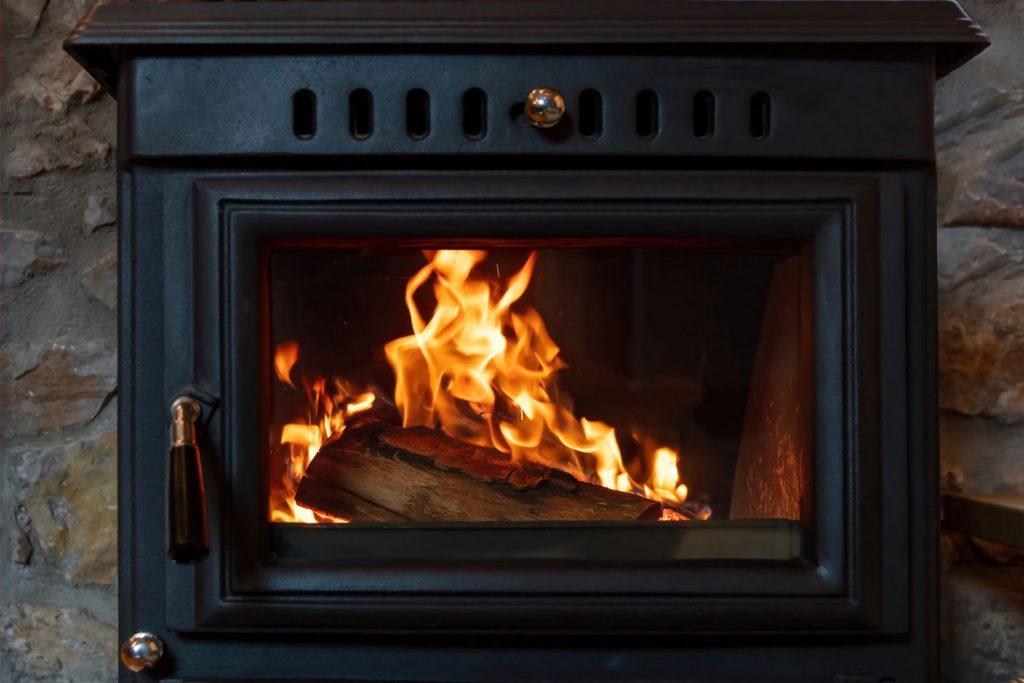
Summer Stove Care
Although you can store your winter clothes in the back of your closet, a stove isn’t that easy to put away. Your multi-fuel stove or wood burner may not be helpful during the spring and summer months, but it will be necessary for keeping the home warm once fall arrives.
Instead of setting it aside and forgetting about it until you’ll need it again, you must take good care of it to ensure its performance throughout the year. Since you won’t have to use your stove during the summer, it’s a good idea to take this time to give it some tender loving care.
Do You Need a New Stove?
Although taking care of your stove is essential, keep in mind that no amount of servicing could restore a broken stove. Before going ahead with your stove maintenance, make sure to take the time to determine if it’s still in working condition or if it looks like it might give away during the first winter night.
To decide whether you should stick with your stove or call a stove installer to replace it with a newer one, watch out for these signs:
- It was manufactured before 1995
- There are signs of warping and cracking
- The stove produces a lot of smoke
- You need to use more wood fuel than before
How to Maintain Your Stove
If you’re sure that your stove can survive a few more winters, then the next thing you have to do is maintain it so that it can operate efficiently and safely. Once the weather is looking a little better, treat your multi-fuel stove or wood-burning stove so that you’re ready for the holidays.
Below are some tips for maintaining your stove’s performance:
Remove Ash and Debris
Before anything else, clean the remaining ash, soot, and debris inside the stove. Take more time on the glass door and fire gate, as those are the areas that accumulate a lot of debris.
Clean the glass on the stove door with a stove glass cleaner, a scratch-free pad, and a clean cloth. If your fire grate has become worn, you can have it replaced, but make sure that it fits properly.
Apply a Fresh Coat of Paint
Refresh your appliance with a new paint finish! If you want to hide any scratches and blemishes, painting it with heat-resistant stove paint will cover them, leaving no trace of the imperfections.
If you’re simply rejuvenating your stove’s existing finish, then you only need one oat. On the other hand, if you’re painting bare metal, you’ll have to build up the finish in several layers, letting it dry in between coats.
Remove Rust
Rust is hardly a problem with modern multi-fuel stoves, but it’s better to check to avoid any issues in the future. If you find rust in your stove, remove it with wire wool and reapply stove paint so that it looks good as new.
Conclusion
The arrival of summer opens up many opportunities to have fun, but there are also several responsibilities you have to fulfil before enjoying the season. During the fireplace offseason, it’s crucial to properly prepare your heating unit so that you can get everything back up and running when you need to use it again in the fall and winter.
Are you looking to maintain or replace your multi-fuel or wood stove? Then, leave it to our team at Stove Scotland to address all of your stove needs! Our business is committed to providing Scotland and the UK with high-quality service and excellent customer satisfaction. Get your free quote today!
Warmth and Convenience: The Basics of Multi-Fuel Stoves
Multi-fuel stoves are a must-have for homes that need warmth. You may find them in houses in colder climates that use the fire to produce warmth and cook meals. The thing about multi-fuel stoves is that they are quite uncommon since most people still use old-fashioned chimneys. However, they are slowly gaining traction, seeing as they offer many advantages that chimneys do not have.
If the concept of multi-fuel stoves is still new to you, do not fret. We have prepared useful information that may help you understand what they’re all about.
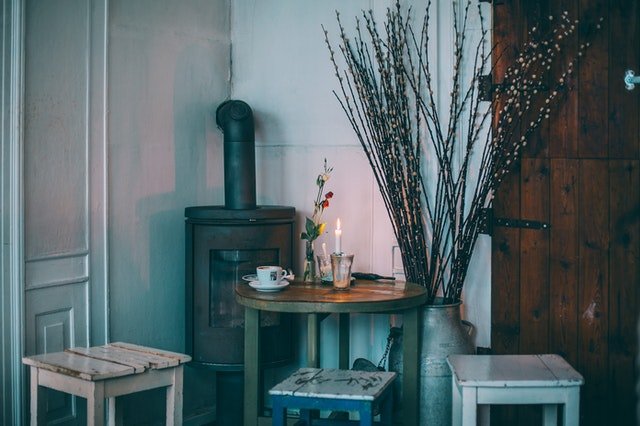
What Are Multi-Fuel Stoves?
Basically, they are stoves that can burn multiple types of fuel. Back then, the average stove could only burn wood, but new variants can also burn coal, peat, and wood pellets to function. Because people are not very familiar with it, there were many misconceptions about its practicality and affordability.
Does It Cost Less to Use a Multi-Fuel Stove?
Wood-burning stoves and multi-fuel stoves, in reality, are very much alike. The cost of using them does not vary too far as well. One uses wood to burn, while the other can use different materials to create heat. The difference lies in the purpose and length of usage.
Wood-burning stoves rely on wood to create warmth. Depending on the type of wood, it may either burn fast or slow. You may spend more money buying wood.
On the other hand, a multi-fuel stove can use coal as its main source of fuel. They last longer than firewood and are perfect for retaining heat. You will not need to spend as much.
Are There Other Factors That Can Affect the Cost of a Multi-Fuel Stove?
Yes, there are. Keeping the misconceptions aside, other factors can affect the pricing of a multi-fuel stove as well. The following are just some of the most common examples.
1. The Brand of the Multi-Fuel Stove
As with all types of products and equipment, the brand name can be a benchmark of its own price. Multi-fuel stoves aren’t exempt from this rule; that is why you may find a couple of them that are priced in the upper ranges. Of course, there is nothing wrong with buying from a recognisable brand; just make sure that the quality of the stove is on par with your standards.
2. The Design of the Multi-Fuel Stove
Another factor that may affect the price of a multi-fuel stove is its overall design. This may not seem like much for someone focusing more on functionality than looks, but the more ornate and intricate its appearance is, the more expensive it could get.
3. The Size of the Multi-Fuel Stove's Viewing Window
Sometimes, people just want to meditate in front of the orange flames. Some multi-fuel stoves have viewing windows on them, well enough for the household to relax and enjoy the warmth and view of crackling flames. Stoves with this feature generally cost more than the average multi-fuel stove.
Conclusion
Multi-fuel stoves are as important as the other amenities in your home. This is especially true if live in a cold environment. Ignore all misconceptions about this wonderful amenity and invest in one. The features, aesthetic advantages, and affordability are just some of the things that you can get in the long run. Pick a brand or design that works best for your household and enjoy the warmth of a well-made stove.
If you’re currently looking for a reliable source of multi-fuel stoves in Scotland, we at Stove Scotland should be your top choice! We supply, install, and maintain a selection of high-quality multi-fuel stoves made by some of the top brands in the market today. Contact us so we can discuss your multi-fuel stove options.
3 Myths About Electric Stoves You Must Be Aware Of
Are you planning to invest in a stove to reduce your carbon emissions and utilize a more modern heat source? If so, you may be considering buying an electric stove!
Also known as an electric fire, there are many benefits to investing in one. For instance, it does not produce any harmful fumes, and it is incredibly easy to clean. That being said, there are plenty of prevalent myths that may affect one's view of the electric stove. Some of these myths can lead to lingering misconceptions that can affect your purchasing decision and overall electric stove experience.
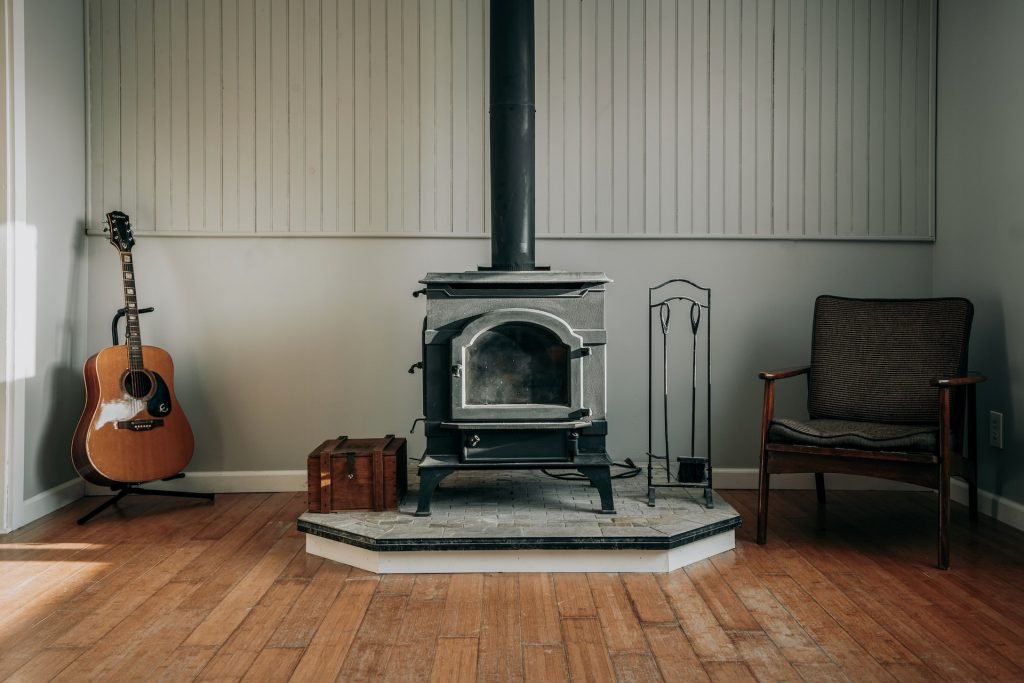
In this article, we're going to tackle some popular myths about the electric stove so that you can make the right decision when investing in one:
Myth #1: Electric Stoves Are Inefficient
You may have heard that electric stoves aren't nearly as efficient as their traditional counterparts. However, this simply isn't true. Many stoves today have been developed with plenty of energy-saving features to keep running costs down.
For example, you can switch off the flame display while keeping the stove on to heat up your room. Some even come with a programmable thermostat feature, meaning the heater can automatically adjust your heating needs. In other words, electric stoves are built to be efficient, making them incredibly affordable to run.
Myth #2: Electric Stoves Don’t Provide Ambiance
Many people love traditional stoves simply because the fire it emits creates a peaceful and cosy ambience. With electric stoves introduced, many people create myths in fear that they cannot create the same ambiance. Fortunately, with today's technology, such ambiance is easily emulated with incredible display technology.
While not all electric stoves will come with such a display, if you want something that can replicate the atmosphere of a traditional stove, there are options out there that you can invest in. An advantage to this is that some stoves allow you to change the color of the fire to fit the exact mood you want to create!
Myth #3: Electric Stoves Are Difficult to Install
Electric stoves are far from challenging to install! All that's really done is carrying the stove to the location you want it to be in, and then plugging it into the wall. That's it! Even if you need to install it into a faux wall, it is still much easier to install compared to a traditional stove.
Apart from its installation convenience, such electric stoves are also easy to maintain. All it needs is some light dusting and cleaning every once in a while, and you're good to go.
Conclusion
If you've heard of any of the myths mentioned above, you now understand why they're all false! Remember, if you run into someone claiming an electric stove can or cannot do something, always do a little research to find out if it is true or not. This way, you can base your decision-making on facts about the stove, ensuring that you maximize your investment to keep your home warm.
That said, do take the time to compare different electric stoves before you decide on buying one. Doing so will allow you to pick the perfect stove to ensure a comfortable and hassle-free experience.
Stove Scotland offers supply, installation, and maintenance services for those in need of a stove. If you are looking for stove installers in Scotland to set up your electric stove and more, contact us today!
4 Common Wood Stove Issues and How to Troubleshoot Them
While wood burners are mainly designed to burn wood, problems start to happen when they spend too much time not doing that. After a long period of not being used, wood burners tend to have trouble firing up. In some cases, some parts may need to be repaired or even replaced before the wood burner can finally work correctly again.
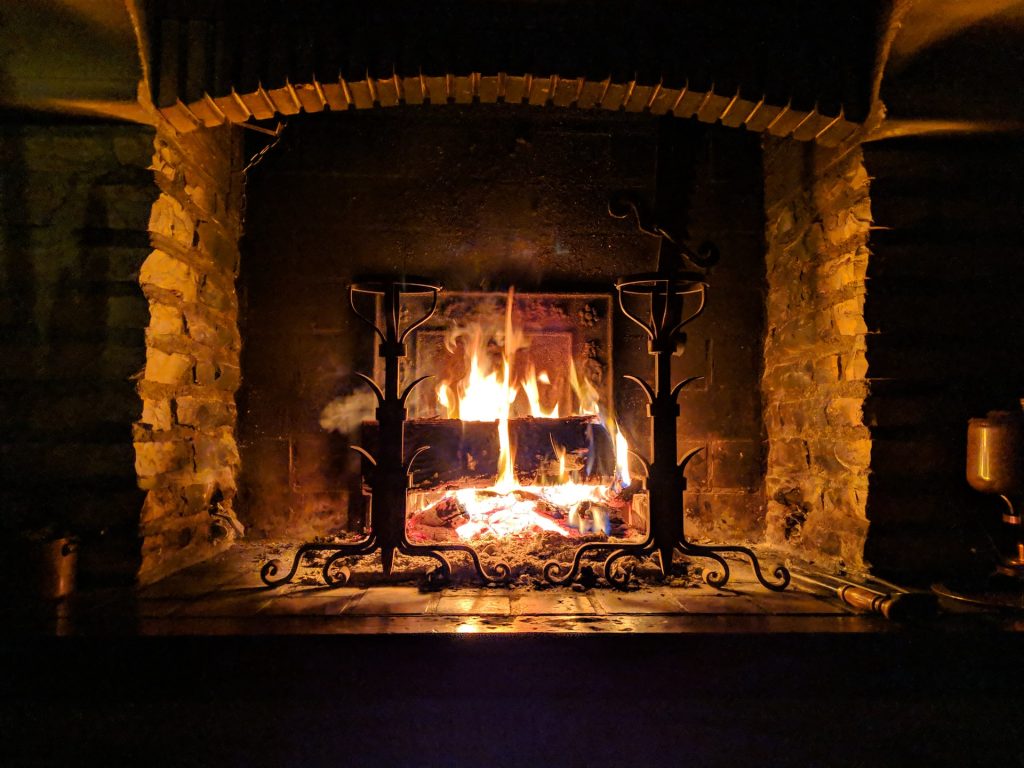
While usually reliable, we can safely deduce that wood burners are not immune to different problems. Some problems can be tiny, but others can be quite severe. In this article, we'll talk about the possible issues a wood burner can face, along with what you can do to troubleshoot them:
1. Soot Forming on the Glass
Soot generally forms on the glass if the wood you are trying to burn is not dry enough. Wet wood when burned will release steam that can cause the soot to form. To stop soot from forming on the glass, always ensure that you are using well-dried and seasoned wood. It’s also important to make sure that the air supply is enough, which allows the stove to have access to oxygen to properly burn the wood.
2. Trouble Lighting up the Stove
Sometimes, it may be the user's mistake that causes the stove to not light up easily. Make sure to reacquaint yourself with the proper firing-up procedure for wood stoves. If that doesn't work, check the chimney to ensure that there is enough draft in there to pull fresh air. Finally, make sure that the wood is dry. Wet wood isn't only hard to light up—it is also toxic. Dry wood is much safer to burn and easily lights up on fire.
3. Smoke Coming Out of the Stove
Generally, smoke is a sign that there's a fire brewing. When it comes to your wood-burning stove, however, there really shouldn't be much smoke—and it shouldn't spill out of the stove. If that happens, chances are that the chimney may be blocked, forcing the smoke to come out from the stove into the room and filling your house with toxic gases. B sure that the chimney is clear from any blockages.
4. Glass on the Stove Turned White or Cracked
While this problem is quite rare, it can still happen. Stove glass that has turned white or cracked means that it has overheated, which is caused by heating up the stove too quickly or using the wrong fuel. Make sure to always use proper fuel and heat up the woodstove slowly. You may need to replace the glass, however.
Conclusion
Although the problems stated above may not commonly happen, there's always a chance that they could. Treating and maintaining your stove properly is a must to ensure the chances of these issues rising is minimal.
Should any of the problems show up, however, stop using the stove immediately and get it fixed. Continuous use will not only put the stove at risk of more damages, but it can also put you and your house members in danger, not to mention put the house at risk of a fire.
Stove Scotland offers multi-fuel and wood-burning stoves in West Lothian in various top brands like Merlin and Pod to ensure your needs are thoroughly satisfied. If you are looking for high-quality wood stoves that you can rely on, check out our offers!
Everything You Need to Know about Buying a Wood Burner
At this point, you may be considering buying a wood-burning stove, but you don’t know enough about it to be sure about this decision. We understand your hesitancy as these types of stoves are completely different from your typical everyday stove at home. However, being different isn’t necessarily a bad thing. While it does come with its own quirks, wood-burning stoves can be a great addition to any home when used correctly.
If you need a little more information on wood-burning stoves, then we’ve got just the thing for you. Here's a quick breakdown of everything that you need to know about buying a wood-burning stove!
What to Consider Before Buying the Stove?
There are a couple of things that you have to consider before purchasing these types of stoves. The main thing that puts people off from going through with their purchase is the environmental impact of the stoves. And while it is true that some appliances are bad for the environment, developments in technology have made it so that there are now stoves that minimise their impact on the environment. Just be sure to get one that’s ecodesign ready, and you’ll have close to nothing to worry about when it comes to its environmental impact!
Aside from the environmental aspect of things, you’ll also want to make sure that you have a chimney to support the stove you’re getting. However, this isn’t something that you can do yourself, so it would be best to set up an appointment with us so that we can help you assess your space!
How to Install a Wood Burning Stove?
Installing your stove can be a breeze as long as it is done by a professional. Trust us when we say that this isn’t something that you’ll want to be doing yourself, as you may not have the expertise to safely and correctly install these types of stoves. As such, you’ll want to be sure to have your stove installed before the winter months, as professional installation services can get quite busy during this time. To avoid any inconveniences, try to put in your request for installation during the summer.
What Can You Do to Prepare for Installation?
While you’ll be making use of professional installation services, this doesn’t mean that you’ll have no role to play when it comes to installation. In fact, you’ll surely have your hands full as you prepare your space for your stove.
The first thing you’ll want to do is to make sure that your chimney is clean because dirty chimneys can cause potential issues that will significantly slow down the installation. Aside from the chimney, you’ll also want to prepare the stove area. The main thing you will have to consider is making enough space for your stove that complies with standard building regulations.
For the most part, all you’ll need to do is to make sure that there is at least 150 mm of space between the stove’s external surfaces and the surrounding walls. Other than that, just make sure to have a non-combustible hearth that’s at least 12mm thick, and you should be good to go!
Conclusion
We hope this article proves to be useful when it comes to helping you purchase your first wood-burning stove. While it may seem rather daunting at first, there’s really nothing to worry about as everything from choosing a stove to the installation itself is a stress-free affair!
Are you looking to buy the best log-burning stoves in Scotland? Stove Scotland has got what you need! We will work with you to ensure that your stove will perfectly fit the style and dimensions of your room. Get in touch with us today to learn more about how we can help!
3 Essential but Easy Tips for Cleaning a Wood-Burning Stove
3 Essential but Easy Tips for Cleaning a Wood-Burning Stove - Wood burning stoves keep you and your family warm and cosy, but they can pose a serious fire hazard when improperly maintained. Maintenance is the key to avoid any health and safety hazards.
Some of the daily maintenance can be done by yourself. However, there are situations where an expert should be called. In this article, we are going to give you tips on cleaning and maintaining your wood-burning stove.

Sweep the Chimney
Sweeping the chimney must only be done by a professional. It is important to always sweep the chimney to remove any burnt residue and for the appliance to function correctly. Chimney sweeping requires knowledge and experience, so it must be done by a professional.
You can schedule a chimney sweeping twice a year. It all depends on the usage. If you frequently use the stove, you need to have it swept more than twice a year. Cleaning the chimneys can protect your family from ailments caused by the soot build-up.
It can also protect your family from fire hazards. Always ask the professional for advice so they can tell you the required sweeping frequency.
Aside from cleaning the chimney, professionals will also conduct smoke tests to ensure your safety. They often check if the flow of gasses from the burning wood is safely released outside of the home. They will also check other safety-related issues, such as the smoke alarm, ventilation, CO, and many more. Afterwards, the professionals will give you a sweep Safe Certificate.
Maintenance of the Internal Components of a Stove
Stoves can last for a very long time, yet the internal components do not. They occasionally break due to their constant use. The doors to the stove may degrade while the hinges become loose. The castings can also crack.
As for the glass of the stove, it can become scratched or milky due to the constant use. It also takes a lot of time before the glass can be replaced by a new one since it is different from normal window glass. The glass for stoves is made from pyro ceramic, which can withstand heat. For these kinds of repairs and replacements, a professional is needed.
Clean the Wood-Burning Stove
There are certain situations where you can clean the stove by yourself. Start by removing the hot coals and wait for them to cool before you clean the wood-burning stove. Then sweep the ash every day to avoid any fire hazards in the future.
Clean the glass, so you can clearly see the flames when using the stove. Regularly check all the controls to ensure everything is working. As for the burning wood, use only seasoned or kiln-dried wood. The flue way must also be checked to ensure there isn’t any soot build-up. Lastly, schedule regular maintenance from a professional.
Final Thoughts
A burning stove can provide heat and warmth, especially during the winter months. Regular maintenance must be practised to ensure everyone’s safety. Work only with registered professionals since they have the knowledge and skills to handle the repair and maintenance of burning stoves.
Stove Scotland is a family business that can help you with your wood stoves in Scotland. We are committed to providing you with high-quality service and customer satisfaction. Reach out to us today!

